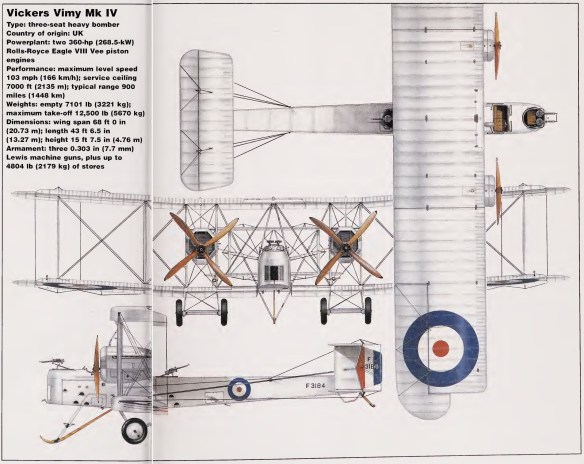
The first F. B. 27 prototype was submitted for official trials in January 1918, and caused something of a sensation by carrying a bomb load heavier than that of the 0/400. The Hispano-Suiza 8 engines were later replaced by a pair of Salmson (Canton-Unné) water-cooled radial engines, each rated at 260 hp (194 kW). The second F. B. 27 prototype was completed in April 1918, with changes that included a powerplant of two Sunbeam Maori Vee engines, each rated at 260 hp (194 kW) and driving a four-blade wooden propeller, a third 0.303 in (7.7 mm) Lewis trainable rearward-firing machine gun added in the ventral position, and the wing cellule revised with plain inversely tapered ailerons with no overhanging balance areas, for a span of 68 ft 4 in (20.83 m) with an area of 1376 sq ft (127.83 m2). This machine was lost as a result of engine failure. The same fate befell the third prototype, which first flew a few weeks after the second prototype using two Fiat A. 12 in-line piston engines, each rated at 260 hp (194 kW). By this time, the F. B. 27A production variant had received the official name Vimy, and was ordered into large-scale production. Vickers received an initial order for 150 aircraft, most of them to be completed as anti-submarine patrol machines to replace the inadequate Blackburn Kangaroo, during March 1918, and then a second contract for 200 machines. Thereafter, a higher rate of production was envisaged for the delivery of large numbers of bombers to support the great Allied offensives planned for 1919, and soon the order book totalled 1130 Vimy aircraft.
There remains some dispute about the official nomenclature adopted for these early aircraft. The more likely account suggests that the first prototype with Hispano-Suiza engines was the Vimy Mk I, the second prototype with Sunbeam engines was the Vimy Mk II, and the third prototype with Fiat engines was the Vimy Mk III, which was therefore the designation applied to the Fiat-engined production model. The less likely account suggests that the Vimy Mks I and II were the Sunbeam- and Fiat-powered prototypes, with the designation Vimy Mk III reserved for a BHP-engined prototype conversion that was not completed.
The Vimy Mk III differed from the Vimy Mk IV in its offensive armament of up to 4408 lb (2000 kg) of bombs in the form of eight 250 lb (113 kg) and four 112 lb (51 kg) bombs carried internally, plus two 520 lb (236 kg) bombs carried under the fuselage, and four 230 lb (104 kg) bombs carried under the lower-wing centre section. The two variants were dimensionally identical. Only three Vimy bombers had reached the Western Front by the time of the Armistice that ended World War I in November 1918, and none of these was used operationally. The Vimy was one of the few British warplanes to survive World War I as a major type, for it was retained as the major post-war heavy bomber of the Royal Air Force. Production eventually totalled at least 224 aircraft in the form of 143 from Vickers, 25 from Westland, 16 or more from the Royal Aircraft Establishment, and at least 40 from Morgan. Some of these machines were of the Vimy Mk III type with the Fiat A. 12bis powerplant, but the considerable majority was of the Vimy Mk IV type that had been pioneered by the fourth prototype which first flew in September 1918 with a powerplant of two Rolls-Royce Eagle VIII Vee piston engines, each rated at 360 hp (268 kW) and driving a four-blade wooden propeller, considerably enlarged fuel capacity, and rudders with larger balance areas. The production standard added a small fixed fin ahead of each rudder.
The Vimy entered full service in July 1919, when it replaced the 0/400 bombers of No 58 Squadron based in Egypt. Its type was replaced in first-line bomber service between 1925 and 1929 by the Vickers Virginia. The Vimy is of enormous historical importance as the aeroplane on which the first non-stop aerial crossing of the Atlantic Ocean was completed, when in June 1919 Captain John Alcock and Lieutenant Arthur Whitten-Brown flew a Vickers-owned Vimy Mk IV with additional fuel tankage over the 1890 miles (3042 km) between St Johns in Newfoundland and Clifden in Ireland. Another highly notable success was the first flight between the UK and Australia, a feat achieved by the brothers Captain Ross Smith and Lieutenant Keith Smith (with Sergeants Bennett and Shiers as their mechanics) in November and December 1919, when they flew a Vimy Mk IV over this 11,130 mile (17,910 km) distance in a flying time of just under 136 hours.